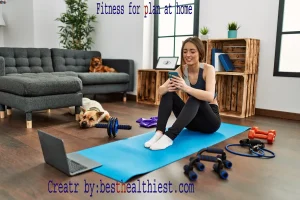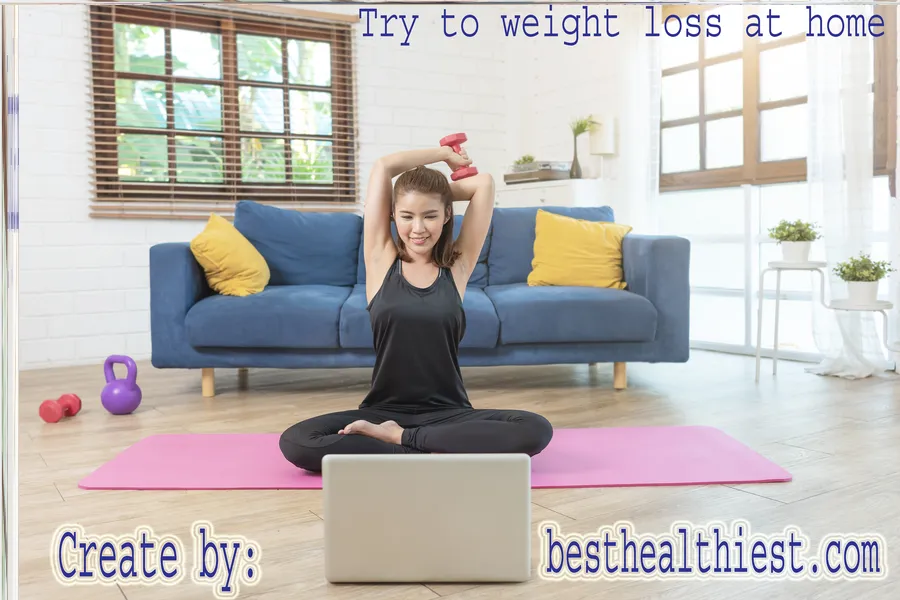Fitness workouts at home offer convenience and flexibility. You don’t need a gym membership to reach your fitness objectives.
Home workouts have gained popularity for their ease and accessibility. They do away with the necessity for costly gear and travel. With just your body weight or minimal gear, you can engage in effective exercises. From HIIT to yoga, the options are diverse and cater to all fitness levels.
Setting a routine at home helps maintain motivation and discipline. Workouts can be customized to meet your interests and schedule. Whether you’re a beginner or an advanced athlete, home workouts can enhance your strength, flexibility, and endurance. Embrace the freedom of exercising in your own space and discover the benefits of a consistent fitness regime.
Introduction To Home Fitness
Home fitness has gained popularity recently. Many people prefer working out at home. It offers convenience, flexibility, and privacy. You don’t have to commute to the gym to work out.
Home workouts can fit any schedule and lifestyle. You don’t need fancy equipment or a large space. Simple exercises can yield great results. Let’s explore the benefits and tips for successful home workouts.
Benefits Of Working Out At Home
- Cost-effective: No gym memberships or travel costs.
- Flexible schedule: Work out whenever it fits your day.
- Comfort: Exercise in your favorite clothes and space.
- Privacy: No need to feel self-conscious around others.
- Variety: Choose any workout style you enjoy.
Setting Realistic Fitness Goals
Setting goals helps keep you motivated. Start with small, achievable goals. Here are some tips:

- Define your main fitness objective.
- Make your goals specific and measurable.
- Break larger goals into smaller steps.
- Set a timeline for each goal.
- Track your progress regularly.
For example:
| Goal | Action Steps | Timeline |
| Lose 5 pounds | Exercise 3 times a week | 1 month |
| Run a mile | Start with walking, then run | 6 weeks |
| Do 10 push-ups | Practice daily, increase gradually | 2 months |
Stay focused and celebrate small victories. Achieving your goals boosts confidence.
Crafting Your Home Workout Space
Creating a dedicated workout area at home boosts motivation. A well-organized space enhances focus and enjoyment. Let’s explore how to set up your perfect workout zone.
Choosing The Right Spot
Select a location with enough room to move freely. Look for a space that offers:
- Good lighting
- Minimal distractions
- Proper ventilation
A corner in the living room or a spare bedroom works well. Keep the area clean and tidy. This helps maintain a positive atmosphere.
Essential Equipment For Beginners
Starting with basic equipment makes home workouts effective. Consider these essentials:
| Equipment | Purpose |
| Dumbbells | Strength training |
| Yoga mat | Comfort for floor exercises |
| Resistance bands | Versatile strength training |
| Jump rope | Cardio workouts |
Start with light weights. Gradually increase as you get stronger. Keep your equipment organized for easy access.
Incorporate bodyweight exercises too. Push-ups, squats, and lunges require no equipment. They build strength and improve flexibility.
Bodyweight Exercises For Strength
Bodyweight exercises build strength without equipment. They use your own weight for resistance. This makes them accessible and effective. You can do them anywhere. Let’s explore two key types: Push-Ups and Squats.
Push-ups And Variations
Push-ups are a classic exercise. They strengthen your chest, shoulders, and arms. Here are some popular variations:
- Standard Push-Ups: Keep your hands shoulder-width apart.
- Put your hands on an elevated surface to perform an inclined push-up.
- Put your feet on an elevated platform to perform decline push-ups.
- Put your hands wider than shoulder-width apart for wide-grip push-ups.
To perform a push-up:
- Start in a plank position.
- Drop until your chest almost touches the ground.
- Push back up to the starting position.
Squats And Lunges
Squats and lunges target your legs and glutes. They improve balance and coordination. Here’s how to perform them:
| Exercise | Steps |
| Squats |
|
| Lunges |
|
Incorporate these exercises into your routine. They are effective and require no equipment. Enjoy the benefits of strength training at home!
High-intensity Interval Training (hiit)
HIIT, or high-intensity interval training, is a well-liked exercise technique. It combines short bursts of intense exercise with rest or low-intensity periods. HIIT can help burn calories quickly and improve fitness. You can do it anywhere, making it perfect for home workouts.
Basics Of Hiit
HIIT involves quick, intense workouts. Here are some key points:
- Duration: Typically lasts 20 to 30 minutes.
- Intensity: Push your limits during high-intensity bursts.
- Rest: Allow short rest periods for recovery.
- Equipment: Use bodyweight or simple equipment like dumbbells.
HIIT improves cardiovascular health and boosts metabolism. It is effective for burning fat and building muscle. Everyone can adjust HIIT to fit their fitness levels.
Sample Hiit Workouts
Here are some simple HIIT workouts you can try at home:
| Exercise | Duration | Rest |
| Jumping Jacks | 30 seconds | 15 seconds |
| Push-Ups | 30 seconds | 15 seconds |
| High Knees | 30 seconds | 15 seconds |
| Squats | 30 seconds | 15 seconds |
Repeat the circuit 3 times. Adjust the rest time based on your fitness level.
Another example includes:
- Burpees – 30 seconds
- Mountain Climbers – 30 seconds
- Plank – 30 seconds
- Rest – 30 seconds
Repeat this circuit 3 to 5 times. HIIT exercises can be both enjoyable and difficult.
Incorporate HIIT into your routine. Feel the benefits of improved fitness and energy. Start today and enjoy your journey toward better health!
Yoga And Flexibility Workouts
Yoga and flexibility workouts are perfect for home fitness. These exercises improve strength, balance, and relaxation. They also enhance overall well-being. Anyone can practice yoga, regardless of fitness level.
Yoga Poses For Beginners
Starting with simple yoga poses can build confidence. Here are some effective poses:
| Pose Name | Description | Benefits |
| Child’s Pose | Sit back on heels, stretch arms forward. | Calms the mind, stretches the back. |
| Downward Dog | Hands and feet on the ground, hips up. | Strengthens arms and legs, stretches spine. |
| Cat-Cow Stretch | Alternate arching and rounding the back. | Improves spinal flexibility, relieves tension. |
| Mountain Pose | Stand tall with feet together, arms at sides. | Improves posture, builds awareness. |
Practice these poses daily. Hold each pose for 30 seconds. Focus on your breath. This helps deepen relaxation.
Incorporating Stretching Into Your Routine
Stretching is essential for flexibility. It can prevent injuries and improve mobility. Here are some tips to add stretching:
- Stretch after workouts.
- Include dynamic stretches before exercises.
- Set a timer for short stretching breaks.
- Use a yoga mat for comfort.
Try these simple stretches:
- Hamstring Stretch: Sit on the floor, reach for your toes.
- Quadriceps Stretch: Stand, pull one foot to your buttocks.
- Stretch your shoulders by crossing one arm over your body.
- Cobra Stretch: Raise your chest while lying on your stomach.
Stay consistent with your routine. Your body will thank you. Embrace the journey towards flexibility and relaxation.
Core Strengthening Routines
Core strengthening routines are essential for overall fitness. A strong core supports your body. It improves balance, stability, and posture.
Planks And Their Benefits
Planks are one of the best core exercises. They engage multiple muscle groups. Here are some key benefits of planks:
- Enhances Stability: Planks improve your balance.
- Strengthens Muscles: They target your abs, back, and shoulders.
- Boosts Metabolism: Planks help burn calories.
- Reduces Injury Risk: A strong core supports your spine.
To perform a plank, follow these steps:
- Start in a push-up position.
- Keep your body in a straight line.
- Hold the position for 20-60 seconds.
- Repeat 3-5 times.
Core Workouts Without Equipment
You don’t need any equipment for effective core workouts. Here are some great exercises:
| Exercise | Duration/Reps | Benefits |
| Russian Twists | 15-20 reps | Works obliques and improves rotational strength. |
| Mountain Climbers | 30 seconds | Increases heart rate and strengthens core. |
| Leg Raises | 10-15 reps | Strengthens lower abs and hip flexors. |
| Side Planks | 15-30 seconds each side | Targets obliques and improves balance. |
Incorporate these exercises into your routine.
Cardiovascular Exercises Indoors
Cardiovascular exercises are vital for heart health and fitness. They increase your heart rate and improve endurance. Indoor workouts can be effective and enjoyable. Simple movements can provide great results.
Jump Rope Techniques
A pleasant and efficient cardio exercise is jumping rope. It improves coordination and burns calories quickly. Here are some jump rope techniques to try:
- Basic Bounce: Keep feet together and jump lightly.
- Alternate Foot Step: Jump as if jogging in place.
- High Knees: Raise knees towards your chest while jumping.
- Side-to-Side: Jump from side to side for variety.
Start with short sessions. Gradually increase your time as you improve. Aim for at least 10 minutes of jumping rope daily.
On-the-spot Jogging
On-the-spot jogging is an easy way to get your heart pumping. It requires no equipment and little space. Follow these steps for effective jogging:

- Stand tall with feet shoulder-width apart.
- Start jogging in place, lifting knees high.
- Swing your arms to maintain momentum.
- Keep your core engaged for balance.
Jog for 5 to 15 minutes. Increase duration as your stamina builds. This exercise is perfect for a quick cardio session.
Cool Down And Recovery
Cooling down after a workout is crucial. It facilitates your body’s return to rest. Recovery techniques improve your fitness and reduce muscle soreness. Let’s explore why cooling down matters and some effective recovery tips.
Importance Of Cooling Down
Cooling down has several benefits:
- Reduces Heart Rate: Gradually lowers your heart rate.
- Prevents Dizziness: Helps avoid light-headedness.
- Decreases Muscle Soreness: Aids in reducing post-workout pain.
- Improves Flexibility: Enhances muscle elasticity.
Incorporating a proper cool down helps your body recover faster. It prepares you for your next workout.
Recovery Techniques And Tips
Here are some effective recovery techniques:
| Technique | Description |
| Stretching: | Focus on major muscle groups. Hold each stretch for 15-30 seconds. |
| Hydration: | Drink water to replenish lost fluids. |
| Foam Rolling: | Use a foam roller to release tight muscles. |
| Rest: | Allow your body time to heal and recover. |
Try these tips to enhance your recovery:
- Set aside 5-10 minutes for cooling down.
- Incorporate deep breathing exercises.
- Use a warm compress on sore areas.
- Get enough sleep for muscle repair.
Follow these practices to maximize your fitness journey. Your body will thank you!
Nutrition And Fitness
A key component of your fitness program is your diet. Proper food choices fuel your workouts. They also help with recovery. Eating right boosts energy levels and improves performance.
Eating For Exercise
Food choices before and after workouts matter. Focus on these key components:
- Carbohydrates: Provide quick energy for workouts.
- Protein: Aids in muscle repair and growth.
- Fats: Offer long-lasting energy for endurance.
Here’s a simple table of meal suggestions:
| Meal | Before Workout | After Workout |
| Snack | Banana or oatmeal | Protein shake or Greek yogurt |
| Meal | Whole grain toast with peanut butter | Grilled chicken with vegetables |
Hydration And Home Workouts
Staying hydrated is vital for performance. Water regulates body temperature. It also helps transport nutrients. Water should be consumed prior to, during, and following exercise.
Follow these hydration tips:
- Every day, consume eight glasses or more of water.
- Increase water intake during intense workouts.
- Consider electrolyte drinks for long sessions.
Use this simple hydration schedule:
- Drink water upon waking up.
- Hydrate before workouts.
- Take small sips during exercise.
- Replenish fluids after workouts.
Tracking Progress And Staying Motivated
Tracking your fitness journey is essential. It keeps you on track and helps you recognize progress. Motivation can fade, but having a plan keeps you engaged. Use tools to measure your progress. Let’s explore some effective ways to stay motivated at home.
Fitness Apps And Journals
Fitness apps and journals are great for tracking workouts. They assist you with goal-setting, exercise recording, and progress tracking. Here are some popular options:
- MyFitnessPal: Tracks calories and workouts.
- Strava: Great for running and cycling.
- Fitbit: Syncs with devices to track daily activity.
- Journal: Write daily workouts and feelings.
Using a journal can boost accountability. Write down your exercises and results. Celebrate small victories to stay motivated.
Creating A Workout Schedule
A workout schedule keeps you organized. It sets clear days for exercise. Follow these simple steps:
- Choose days: Pick 3-5 days a week.
- Set time: Allocate specific times for workouts.
- Mix it up: Include strength, cardio, and flexibility.
- Rest days: Schedule rest days for recovery.
Here’s a sample weekly workout schedule:
| Day | Workout Type |
| Monday | Strength Training |
| Tuesday | Cardio |
| Wednesday | Flexibility (Yoga) |
| Thursday | Strength Training |
| Friday | Cardio |
| Saturday | Active Rest (Light Walk) |
| Sunday | Rest Day |
Stick to your schedule. Adjust it as needed. Tracking progress helps you stay on track. Celebrate achievements big and small.
Final Thought:
Home workouts offer convenience and flexibility. They are simple to incorporate into your hectic schedule. With numerous exercises available, it’s simple to create a routine that suits your needs. At home, embrace the path to fitness. Start today, and enjoy the benefits of a healthier lifestyle without the gym.











